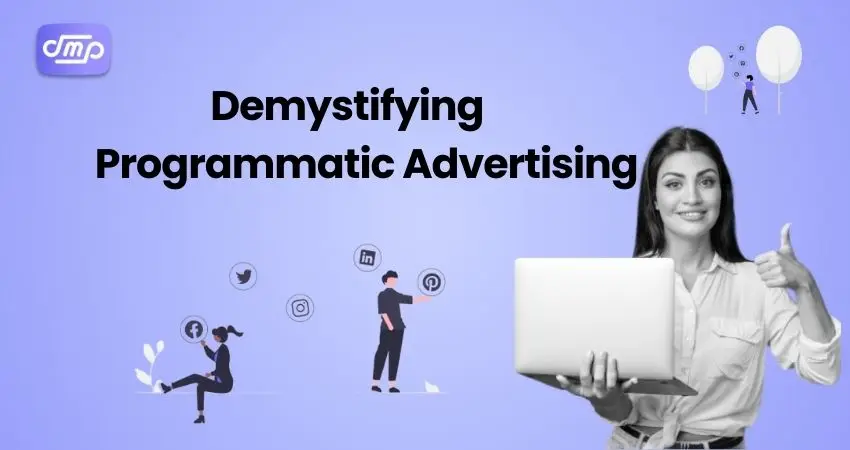
- June 22, 2024
- Programmatic Advertising
- Digital Marketing
Table of Contents
In the dynamic field of digital marketing, programmatic advertising has emerged as a groundbreaking strategy. The process of purchasing and selling ad space is automated by this technologically advanced approach, increasing its effectiveness and efficiency. In contrast to traditional advertising, which frequently entails direct placements and laborious negotiations, programmatic advertising makes use of real-time data and algorithms to buy online ad impressions. By sending tailored advertisements to the appropriate individuals at the appropriate times, this automation enables marketers to reach their target audiences with accuracy and scale. As a result, companies may maximize their advertising budgets, enhance the effectiveness of their campaigns, and eventually increase return on investment.
What is Programmatic Advertising?

Using automated technologies and real-time data, programmatic advertising is a sophisticated method for buying and selling digital ad space.
Programmatic advertising automates the ad-buying process through the use of software and algorithms, as opposed to traditional advertising, which depends on manual procedures like direct placements and negotiations.
The basic idea behind programmatic advertising is to employ different platforms and technology to target audiences with adverts at the appropriate time and location.
Online marketplaces known as “ad exchanges” are where buyers and sellers of digital advertising come together to exchange inventory. Transactions in real time are facilitated by these exchanges.
Ad impressions are bought and sold in real-time, much to a stock market, using a technique known as real-time bidding (RTB). An auction takes place in milliseconds when a person visits a website, giving marketers the chance to bid on the chance to show their advertisement to that particular visitor.
Demand-Side Platforms (DSPs), are websites that allow advertisers to purchase ad inventory automatically. With DSPs, marketers may optimize their bids according to targeting criteria by managing many ad exchanges and data sources via a single interface.
Supply-side platforms (SSPs) are tools used by publishers to optimize, promote, and manage their available inventory of ads. SSPs link publishers to a variety of ad exchanges and purchasers in order to optimize their revenue.
Ads that are programmatically placed can be precisely targeted and personalized. Through the utilization of data such as demographics, hobbies, browsing patterns, and previous purchases, advertisers are able to customize their messaging for specific individuals. By ensuring that advertisements are pertinent to the intended demographic, this degree of targeting raises engagement and boosts conversion rates.
Programmatic advertising makes the process of purchasing ads more streamlined, scalable, and data-driven. Advertisers may more precisely target the demographics they want to reach, while publishers can maximize income by optimizing their ad inventory.
Programmatic advertising is becoming a vital tool for businesses trying to improve their advertising tactics as digital marketing keeps evolving.
How Programmatic Advertising Works
Using cutting-edge technology and real-time data, programmatic advertising automates the purchasing and selling of digital ad space.
- Ad Inventory Accessibility: Publishers use ad exchanges to make their inventory, or ad space, available. A variety of formats, such as display, video, mobile, and social media ads, may be included in this inventory.
- Exchanges for Ads: Ad exchanges are online markets where marketers (buyers) and publishers (sellers) come together to swap ad inventory. These platforms enable instantaneous transactions by establishing connections between prospective advertisers and numerous publishers.
- Instantaneous Bidding (RTB): The ad exchange instantly starts an auction when a user visits a website. Advertisers bid on the available ad impressions during this auction. The highest bidder is guaranteed to receive the ad space during this millisecond-long process.
- Platforms on the Demand Side (DSPs): Advertisers buy ad inventory programmatically through DSPs. Advertisers can define their budget, bid price, and targeting parameters with a DSP. By connecting to several ad exchanges and data sources, it optimizes bids according to audience data and advertiser goals.
- Platforms on the supply side (SSPs): Publishers utilize SSPs to control their ad inventory and maximize revenue. SSPs make connections with numerous ad exchanges and prospective advertisers to guarantee that publishers receive the highest rate for their space.
- Customization and Targeting: To target particular audiences, advertisers use data from several sources (such as user demographics, interests, browsing habits, and previous purchases). By ensuring that advertisements are pertinent to the consumer, this data-driven strategy raises engagement and conversion rates.
- Ad Distribution: The advertisement is sent to the user’s device after the auction is over and the winning bid is known. Users are guaranteed to view the most relevant adverts in real-time thanks to this fast approach.
- Monitoring and Data Analysis: Platforms for programmatic advertising offer thorough reporting and analytics. Important metrics like impressions, clicks, conversions, and return on investment (ROI) are all measurable for advertisers. Advertisers can use this data to refine their advertisements and gradually increase campaign performance.
Important Elements of the Programmatic Ecosystem
Ad Exchanges: Marketplaces for the purchase and sale of advertising inventory.
Real-Time Bidding (RTB): This Includes an automated ad impression auction system.
Demand-Side Platforms (DSPs):Resources that let marketers buy ad space in a programmatic manner.
Supply-Side Platforms (SSPs): Ad inventory management and sales tools for publishers are provided by supply-side platforms or SSPs.
Platforms for managing data (DMPs):Systems that gather and examine information to improve personalization and targeting.
The combination of automation, data, and real-time bidding in programmatic advertising is revolutionizing the digital advertising environment. By using this strategy, advertisers can make sure that the correct message reaches the right target at the right moment, improving results and increasing return on investment.
Benefits of Programmatic Advertising
Many marketers and advertisers use programmatic advertising because it provides a number of benefits.
- Automation and Efficiency: By automating the ad buying process, manual placements and discussions take less time and effort.
- Streamlined Workflow: By centralizing the purchase and administration of advertising through DSPs and other platforms, it becomes simpler to manage numerous campaigns and channels from a single interface.
- Precise Targeting Audience Segmentation: Enables highly targeted marketing by using data to segment consumers according to demographics, interests, behavior, and more.
- Personalization: Targets specific audience segments with communications that are tailored to each individual user, hence enhancing relevance and engagement.
- Instant Feedback: Gives marketers access to real-time information and analytics so they can keep an eye on their campaigns allowing advertisers to track the effectiveness of their campaigns and quickly make data-driven changes.
- Enhanced Optimization: This method maximizes return on investment and improves performance by continuously optimizing campaigns using real-time data.
- Increased Return on Investment: Lowers the amount of wasted impressions and clicks by directing ad expenditure to the most appropriate audiences. With dynamic pricing, advertisers only pay for the worth of the ad space by using real-time bidding to find the best price for each impression of the advertisement.
- Broad Reach: Enables marketers to connect with a wide range of consumers through a variety of platforms and channels, such as social media, video, desktop, and mobile.
- Worldwide Reach: Facilitates the effortless scaling of campaigns to penetrate international markets, offering access to a worldwide viewership.
- More Engagement: By using accurate targeting and customisation, ads become more relevant and generate better engagement rates.
- Improved Conversions: Increases the probability of conversions by presenting the appropriate content to the appropriate individual at the appropriate moment.
- Detailed information: Provides complete transparency into campaign effectiveness by offering in-depth information on a range of metrics, including impressions, clicks, conversions, and cost.
- Ad Inventory Control: Ensuring brand safety and relevancy, this feature allows advertisers to choose where their ads run.
- Real-Time Adjustments: Based on current performance data, real-time adjustments to targeting, creative, and bidding methods are possible.
- High-quality Placements: Gives you access to exclusive ad stock inventory from premium publishers, guaranteeing that advertisements run in prestigious, brand-safe settings.
- Data-Informed Choices: Makes use of extensive audience data to improve overall marketing strategies and offer deeper insights into the interests and behavior of its target market.
All of these advantages assist advertisers in running more successful, economical, and impactful advertising campaigns. Adopting programmatic advertising can greatly improve your marketing efforts as the digital advertising landscape changes, leading to better outcomes and a higher return on investment.
Types of Programmatic Advertising

Programmatic advertising includes a range of approaches and formats that are tailored to specific advertising objectives and tactics. The primary forms of programmatic advertising are as follows:
- Banner Ads: Banner ads are the still or moving pictures that appear on websites. Interactive advertisements with the potential to incorporate audio, video, or other user-engaging components.
- Video Ads In-Stream Video Ads: On websites like YouTube or streaming services, these advertisements appear before (pre-roll), during (mid-roll), or after (post-roll) video content. Video advertisements that show up outside of video content, as in articles or social media feeds, are known as out-stream video ads.
- Mobile In-App Ads: These are advertisements that show up inside mobile apps. These could be in the form of interstitials, banner adverts, or engagement-based video rewards. These are advertisements that show up on websites that have been designed for touch interaction and smaller screens.
- Social Media Promotions: Advertisements that appear in consumers’ social media feeds on Facebook, Instagram, and Twitter. Brief, captivating advertisements that show up inside tales on social media sites like Snapchat and Instagram.
- Native Ads In-Feed Ads: These are advertisements that mix in perfectly with the website or app’s content to offer a non-intrusive user experience. On content-heavy websites, sponsored content recommendations show up as suggested articles or movies.
- Audio Ads Streaming Audio Ads: These are advertisements that play on websites that stream audio, such Pandora or Spotify. Podcast advertisements are sponsored messages or parts of episodes of podcasts.
- Pre-negotiated Programmatic Direct Guaranteed Deals: Pre-arranged contracts for a predetermined quantity of ad inventory at a predetermined cost between publishers and advertisers. Non-guaranteed deals known as “preferred deals” give advertisers first dibs on ad inventory at a predetermined price before it goes up for auction.
- Programmatic TV Connected TV (CTV) Advertising: Commercials displayed on televisions that are internet-connected, like game consoles, smart TVs, and streaming devices. Personalized TV advertising made possible by ads that are sent to certain households based on data-driven targeting.
- Programmatic DOOH (Digital Out-of-Home): Digital Out-of-Home, or DOOH, advertising that is targeted and purchased programmatically appears on digital billboards, screens in public areas, and transit displays.
Conclusion
There are many different formats available for programmatic advertising to meet various target populations and marketing goals. In the event that you want to Programmatic advertising offers the tools and technology to optimize your campaigns for maximum impact, whether your goal is to reach consumers who are on the go with mobile ads, engage users with visually rich display ads, grab their attention with video, or integrate seamlessly with native and social media platforms. Knowing these many forms of programmatic advertising enables you to select the most effective strategy for achieving your advertising objectives and improving performance.











